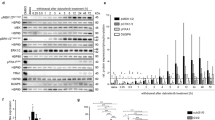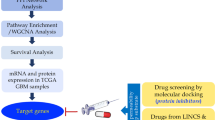Abstract
This study determines the influence of transformed root (TR) extract of Leonurus sibiricus L. on various grades (I-III) of human glioma cells derived from patients. This plant occurs in southern Asia and Siberia and is widely used as a medicinal plant with various biological activities. Chromatographic profile of TR extract have revealed the presence of various polyphenolic compounds (4-hydroxybenzoic acid, gentisic acid, vanilic acid, 1,3-dicaffeoylquinic acid, α-resorcylic acid). We found TR root extract to have antiproliferative activity on glioma cells after 24 h of treatment. TR root extract induces apoptosis on various grades (I-III) of human glioma cells by the generation of reactive oxygen species (ROS) along with concurrent loss of mitochondrial membrane potential, enhanced S and G2/M phases of the cell cycle, and altered mRNA levels of Bax, Bcl-2, p53, Cas-3, Cas-8 and Cas-9 factors involved in apoptosis. This work for the first time demonstrate that TR extract from L. sibiricus root has the potential to activate apoptosis in grade I-III human glioma cells through the intrinsic and extrinsic pathways.



Similar content being viewed by others
References
Wen PY, Kesari S (2008) Malignant gliomas in adults. N Engl J Med 359(5):492–507
Stupp R, Mason WP, van den Bent MJ, Weller M, Fisher B, Taphoorn MJ et al (2005) Radiotherapy plus concomitant and adjuvant temozolomide for glioblastoma. N Engl J Med 352(10):987–996
Stupp R, Hegi ME, Mason WP, van den Bent MJ, Taphoorn MJ, Janzer RC et al (2009) Effects of radiotherapy with concomitant and adjuvant temozolomide versus radiotherapy alone on survival in glioblastoma in a randomised phase III study: 5-year analysis of the EORTC-NCIC trial. Lancet Oncol 10(5):459–466
Cheng L, Wu Q, Guryanova OA, Huang Z, Huang Q, Rich JN et al (2011) Elevated invasive potential of glioblastoma stem cells. Biochem Biophys Res Commun 406(4):643–648
Kortmann RD, Jeremic B, Weller M, Plasswilm L, Bamberg M (2003) Radiochemotherapy of malignant glioma in adults. Clinical experiences. Strahlentherapie und Onkologie 179(4):219–232
Atmaca H, Bozkurt E (2016) Apoptotic and anti-angiogenic effects of Salvia triloba extract in prostate cancer cell lines. Tumor Biol 37(3):3639–3364
Peng X, Zhuang DD, Guo QS (2015) Induction of S phase arrest and apoptosis by ethyl acetate extract from Tetrastigma hemsleyanum in human hepatoma HepG2 cells. Tumor Biol 36(4):2541–2550
Skała E, Sitarek P, Toma M, Szemraj J, Radek M, Nieborowska-Skorska M, Skorski T, Wysokińska H, Śliwiński T (2016) Inhibition of human glioma cell proliferation by altered Bax/Bcl-2-p53 expression and apoptosis induction by Rhaponticum Carthamoides extracts from transformed and normal roots. J Pharm Pharmacol 68(11):1454–1464. doi:10.1111/jphp.12619
Shang X, Pan H, Wang X, He H, Li M (2014) Leonurus japonicus Houtt.: ethnopharmacology, phytochemistry and pharmacology of an important traditional Chinese medicine. J Ethnopharmacol 152(1):14–32. doi:10.1016/j.jep.2013.12.052
Chinwala MG, Gao M, Dai J, Shao J (2003) In vitro anticancer activities of Leonurus Heterophyllus sweet (Chinese motherwort herb). J Altern Complement 9(4):511–518
Sitarek P, Skała E, Toma M, Wielanek M, Szemraj J, Kolasa M, Nieborowska-Skorska M, Skorski T, Wysokińska H, Śliwiński T (2016a) A preliminary study of apoptosis induction in glioma cells via alteration of the Bax/Bcl-2-p53 axis by transformed and non-transformed root extracts of Leonurus sibiricus L. Tumor Biol 1–12
Schenk RU, Hildebrandt AC (1972) Medium and techniques for induction of growth of monocotyledonous and dicotyledonous plant cell cultures. Can J Bot 50:199–204
Skała E, Kicel A, Olszewska MA, Kiss AK, Wysokińska H (2015) Establishment of hairy root cultures of Rhaponticum carthamoides (Willd.) Iljin for the production of biomass and caffeic acid derivatives. Biomed Res Int 181098:1–11
Sitarek P, Skała E, Wysokińska H, Wielanek M, Szemraj J, Toma M, Śliwiński T (2016b) The effect of Leonurus sibiricus plant extracts on stimulating repair and protective activity against oxidative DNA damage in CHO cells and content of phenolic compounds. Oxidative Med Cell Longev 5738193:1–11. doi:10.1155/2016/5738193
Kleihues P, Louis DN, Scheithauer BW, Rorke LB, Reifenberger G, Burger PC, Cavenee WK (2002) The WHO classification of tumors of the nervous system. J Neuropathol Exp Neurol 61:215–225 discussion 226–9
Mosmann T (1983) Rapid colorimetric assay for cellular growth and survival: application to proliferation and cytotoxicity assays. J Immunol Methods 65:55–63
Rogalska A, Koceva-Chyla A, Jozwiak Z (2008) Aclarubicin-induced ROS generation and collapse of mitochondrial membrane potential in human cancer cell lines. Chem Biol Interact 176(1):58–70
Qu Y, Zhang J, Wu S, Li B, Liu S, Cheng J (2012) SIRT1 promotes proliferation and inhibits apoptosis of human malignant glioma cell lines. Neurosci Lett 525(2):168–172
Agrawal M (2015) Natural polyphenols based new therapeutic avenues for advanced biomedical applications. Drug Metab Rev 47(4):420–430. doi:10.3109/03602532.2015.1102933
Orfali G, Duarte AC, Bonadio V, Martinez NP, de Araújo ME, Priviero FB, Carvalho PO, Priolli DG (2016) Review of anticancer mechanisms of isoquercitin. World J Clin Oncol 7(2):189–199. doi:10.5306/wjco.v7.i2.189
Zhou XJ, Liu M, Yan JJ, Cao Y, Liu P (2012) Antidepressant-like effect of the extracted of Kai Xin san, a traditional Chinese herbal prescription, is explained by modulation of the central monoaminergic neurotransmitter system in mouse. J Ethnopharmacol 139(2):422–428
Hengartner MO (2002) The biochemistry of apoptosis. Nature 407:770–776
de Kok TM, van Breda SG, Manson MM (2008) Mechanisms of combined action of different chemopreventive dietary compounds: a review. Eur J Nutr 47(2):51–59
Mertens-Talcott SU, Talcott ST, Percival SS (2003) Low concentrations of quercetin and ellagic acid synergistically influence proliferation, cytotoxicity and apoptosis in MOLT-4 human leukemia cells. J Nutr 133:2669–2674
Shimizu M, Deguchi A, Lim JT, Moriwaki H, Kopelovich L, Weinstein IB (2005) (−)-Epi-gallocatechin gallate and polyphenon E inhibit growth and activation of the epidermal growth factor receptor and human epidermal growth factor receptor-2 signaling pathways in human colon cancer cells. Clin Cancer Res 11:2735–2746
Dong XC, Bin Q, Zhi-Qiang G, Ying JY (2012) Comparison of burst of reactive oxygen species and activation of caspase-3 in apoptosis of K562 and HL-60 cells induced by docetaxel. Cancer Lett 214:103–113
Ying-Tang H, Yi-Hsuan H, Tzhy-Chyuan H, Bonnie SP, Yeuk CL, Min-Hsiung P (2006) Apoptosis-inducing active components from Corbicula fluminea through activation of caspase-2 and production of reactive oxygen species in human leukemia HL-60 cells. Food Chem Toxicol 44:1261–1272
Nunes C, Barbosa MRL, Laranjinha J (2011) Nitric oxide and DOPAC-induced cell death: from GSH. Depletion to mitochondrial energy crisis. Mol Cell Neurosci 48:94–103
Sipos L, Szegedi Z, Fedorcsak I, Áfra D, Szende B (1998) Apoptosis and p53 expression in human gliomas. Pathol Oncol Res 4(4):267–270
Kug CK, Jin SK, Jung KS, In Gyu K (2007) Enhance induction of mitochondrial damage and apoptosis in leukemia HL-60 cells by the Ganoderma lucidum and Duchesnea chysantha extracts. Cancer Lett 246:210–217
Muhammad K, Chuan D, Azhar R, Fei Y, Ting L, Hongwen G, Rong G, Lili Z, Kun Z, Xuedong F, Tonghui M (2012) Isoalantolactone induces reactive oxygen species mediated apoptosis in pancreatic carcinoma PANC-1 cells. Int J Biol Sci 8(4):533–547
Stowe DF, Camara AK (2009) Mitochondrial reactive oxygen species production in excitable cells: modulators of mitochondrial and cell function. Antioxid Redox Signal 11:1373–1414
Kagan VE, Tyurin VA, Jiang J et al (2005) Cytochrome c acts as a cardiolipin oxygenase required for release of proapoptotic factors. Nat Chem Biol 1(4):223–232
Juan ME, Wenzel U, Daniel H, Planas JM (2008) Resveratrol induces apoptosis through ROS-dependent mitochondria pathway in HT-29 human colorectal carcinoma cells. J Agric Food Chem 56(12):4813–4818
Garcia A, Morales P, Arranz N, Delgado ME, Rafter J, Haza AI (2009) Antiapoptotic effects of dietary antioxidants towards N-nitrosopiperidine and N-nitrosodibutylamine-induced apoptosis in HL-60 and HepG2 cells. J Appl Toxicol 29(5):403–413
Author information
Authors and Affiliations
Corresponding author
Ethics declarations
Conflict of Interest
The authors declare that there is no conflict of interests regarding the publication of this paper.
Rights and permissions
About this article
Cite this article
Sitarek, P., Skała, E., Toma, M. et al. Transformed Root Extract of Leonurus sibiricus Induces Apoptosis through Intrinsic and Extrinsic Pathways in Various Grades of Human Glioma Cells. Pathol. Oncol. Res. 23, 679–687 (2017). https://doi.org/10.1007/s12253-016-0170-6
Received:
Accepted:
Published:
Issue Date:
DOI: https://doi.org/10.1007/s12253-016-0170-6




